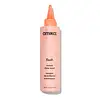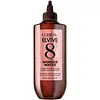What's inside
What's inside
 Key Ingredients
Key Ingredients

 Benefits
Benefits

 Concerns
Concerns

 Ingredients Side-by-side
Ingredients Side-by-side

Water
Skin ConditioningGlycerin
HumectantHydrolyzed Linseed Seed
HumectantVitis Vinifera Leaf Extract
Skin ConditioningWine Extract
AntioxidantGlycine Soja Germ Extract
EmollientScutellaria Baicalensis Root Extract
AstringentHippophae Rhamnoides Fruit/Seed Oil
AntimicrobialTriticum Vulgare Germ Extract
Skin ConditioningGlycine
BufferingAlanine
MaskingArginine
MaskingAspartic Acid
MaskingHistidine
HumectantIsoleucine
Skin ConditioningPhenylalanine
MaskingProline
Skin ConditioningSerine
MaskingThreonine
Valine
MaskingLactic Acid
BufferingCetrimonium Chloride
AntimicrobialSodium PCA
HumectantSodium Lactate
BufferingPCA
HumectantCitric Acid
BufferingBenzophenone-4
UV AbsorberLactobacillus Ferment
Skin ConditioningCalcium Gluconate
HumectantPropylene Glycol
HumectantPolyquaternium-7
Polyquaternium-10
Cellulose
AbsorbentPolysorbate 20
EmulsifyingPropanediol
SolventSilicone Quaternium-8
Trideceth-10
CleansingHydroxyethylcellulose
Emulsion StabilisingEthylhexylglycerin
Skin ConditioningGluconolactone
Skin ConditioningSodium Acetate
BufferingPotassium Sorbate
PreservativeSodium Benzoate
MaskingBenzyl Alcohol
PerfumingPhenoxyethanol
PreservativeIsopropyl Alcohol
SolventParfum
MaskingHydroxycitronellal
PerfumingLimonene
PerfumingWater, Glycerin, Hydrolyzed Linseed Seed, Vitis Vinifera Leaf Extract, Wine Extract, Glycine Soja Germ Extract, Scutellaria Baicalensis Root Extract, Hippophae Rhamnoides Fruit/Seed Oil, Triticum Vulgare Germ Extract, Glycine, Alanine, Arginine, Aspartic Acid, Histidine, Isoleucine, Phenylalanine, Proline, Serine, Threonine, Valine, Lactic Acid, Cetrimonium Chloride, Sodium PCA, Sodium Lactate, PCA, Citric Acid, Benzophenone-4, Lactobacillus Ferment, Calcium Gluconate, Propylene Glycol, Polyquaternium-7, Polyquaternium-10, Cellulose, Polysorbate 20, Propanediol, Silicone Quaternium-8, Trideceth-10, Hydroxyethylcellulose, Ethylhexylglycerin, Gluconolactone, Sodium Acetate, Potassium Sorbate, Sodium Benzoate, Benzyl Alcohol, Phenoxyethanol, Isopropyl Alcohol, Parfum, Hydroxycitronellal, Limonene
Propylene Glycol
HumectantAlcohol Denat.
AntimicrobialMyristyl Alcohol
EmollientWater
Skin ConditioningParfum
MaskingCI 14700
Cosmetic ColorantDicaprylyl Carbonate
EmollientCocos Nucifera Oil
MaskingTocopherol
AntioxidantSodium Benzoate
MaskingPaeonia Officinalis Flower Extract
TonicBehentrimonium Chloride
PreservativeEthylhexyl Salicylate
UV AbsorberBenzyl Alcohol
PerfumingBenzyl Salicylate
PerfumingLinalool
PerfumingIsopropyl Alcohol
SolventAlpha-Isomethyl Ionone
PerfumingGeraniol
PerfumingCetrimonium Chloride
AntimicrobialCitronellol
PerfumingPotassium Sorbate
PreservativeCitric Acid
BufferingHexyl Cinnamal
PerfumingGlycerin
HumectantPropylene Glycol, Alcohol Denat., Myristyl Alcohol, Water, Parfum, CI 14700, Dicaprylyl Carbonate, Cocos Nucifera Oil, Tocopherol, Sodium Benzoate, Paeonia Officinalis Flower Extract, Behentrimonium Chloride, Ethylhexyl Salicylate, Benzyl Alcohol, Benzyl Salicylate, Linalool, Isopropyl Alcohol, Alpha-Isomethyl Ionone, Geraniol, Cetrimonium Chloride, Citronellol, Potassium Sorbate, Citric Acid, Hexyl Cinnamal, Glycerin
 Reviews
Reviews

Ingredients Explained
These ingredients are found in both products.
Ingredients higher up in an ingredient list are typically present in a larger amount.
Benzyl Alcohol is most commonly used as a preservative. It also has a subtle, sweet smell. Small amounts of Benzyl Alcohol is not irritating and safe to use in skincare products. Most Benzyl Alcohol is derived from fruits such as apricots.
Benzyl Alcohol has both antibacterial and antioxidant properties. These properties help lengthen the shelf life of products. Benzyl Alcohol is a solvent and helps dissolve other ingredients. It can also improve the texture and spreadability.
Alcohol comes in many different forms. Different types of alcohol will have different effects on skin. This ingredient is an astringent alcohol.
Using high concentrations of these alcohols are drying on the skin. They may strip away your skin's natural oils and even damage your skin barrier. Astringent alcohols may also irritate skin.
Other types of astringent alcohols include:
According to the National Rosacea Society based in the US, you should be mindful of products with these alcohols in the top half of ingredients.
Any type of sanitizing product will have high amounts of alcohol to help kill bacteria and viruses.
Learn more about Benzyl AlcoholThis ingredient is a preservative, antimicrobial, and emulsifier. It is often used in cosmetics for its ability to cleanse, condition, and reduce static.
Cetrimonium chloride is a quaternary ammonium salt, meaning it has a water-soluble structure.
Citric Acid is an alpha hydroxy acid (AHA) naturally found in citrus fruits like oranges, lemons, and limes.
Like other AHAs, citric acid can exfoliate skin by breaking down the bonds that hold dead skin cells together. This helps reveal smoother and brighter skin underneath.
However, this exfoliating effect only happens at high concentrations (20%) which can be hard to find in cosmetic products.
Due to this, citric acid is usually included in small amounts as a pH adjuster. This helps keep products slightly more acidic and compatible with skin's natural pH.
In skincare formulas, citric acid can:
While it can provide some skin benefits, research shows lactic acid and glycolic acid are generally more effective and less irritating exfoliants.
Most citric acid used in skincare today is made by fermenting sugars (usually from molasses). This synthetic version is identical to the natural citrus form but easier to stabilize and use in formulations.
Read more about some other popular AHA's here:
Learn more about Citric AcidGlycerin is already naturally found in your skin. It helps moisturize and protect your skin.
A study from 2016 found glycerin to be more effective as a humectant than AHAs and hyaluronic acid.
As a humectant, it helps the skin stay hydrated by pulling moisture to your skin. The low molecular weight of glycerin allows it to pull moisture into the deeper layers of your skin.
Hydrated skin improves your skin barrier; Your skin barrier helps protect against irritants and bacteria.
Glycerin has also been found to have antimicrobial and antiviral properties. Due to these properties, glycerin is often used in wound and burn treatments.
In cosmetics, glycerin is usually derived from plants such as soybean or palm. However, it can also be sourced from animals, such as tallow or animal fat.
This ingredient is organic, colorless, odorless, and non-toxic.
Glycerin is the name for this ingredient in American English. British English uses Glycerol/Glycerine.
Learn more about GlycerinIsopropyl Alcohol is more commonly known as rubbing alcohol. It is most commonly used as a solvent, meaning it helps other ingredients dissolve.
This ingredient is an astringent alcohol. Astringent alcohols may also irritate skin as they high amounts may strip away your skin's natural oils.
Other types of astringent alcohols include:
According to the National Rosacea Society based in the US, you should be mindful of products with these alcohols in the top half of ingredients.
Any type of sanitizing product will have high amounts of alcohol to help kill bacteria and viruses.
Learn more about Isopropyl AlcoholParfum is a catch-all term for an ingredient or more that is used to give a scent to products.
Also called "fragrance", this ingredient can be a blend of hundreds of chemicals or plant oils. This means every product with "fragrance" or "parfum" in the ingredients list is a different mixture.
For instance, Habanolide is a proprietary trade name for a specific aroma chemical. When used as a fragrance ingredient in cosmetics, most aroma chemicals fall under the broad labeling category of “FRAGRANCE” or “PARFUM” according to EU and US regulations.
The term 'parfum' or 'fragrance' is not regulated in many countries. In many cases, it is up to the brand to define this term.
For instance, many brands choose to label themselves as "fragrance-free" because they are not using synthetic fragrances. However, their products may still contain ingredients such as essential oils that are considered a fragrance by INCI standards.
One example is Calendula flower extract. Calendula is an essential oil that still imparts a scent or 'fragrance'.
Depending on the blend, the ingredients in the mixture can cause allergies and sensitivities on the skin. Some ingredients that are known EU allergens include linalool and citronellol.
Parfum can also be used to mask or cover an unpleasant scent.
The bottom line is: not all fragrances/parfum/ingredients are created equally. If you are worried about fragrances, we recommend taking a closer look at an ingredient. And of course, we always recommend speaking with a professional.
Learn more about ParfumPotassium Sorbate is a preservative used to prevent yeast and mold in products. It is commonly found in both cosmetic and food products.
This ingredient comes from potassium salt derived from sorbic acid. Sorbic acid is a natural antibiotic and effective against fungus.
Both potassium sorbate and sorbic acid can be found in baked goods, cheeses, dried meats, dried fruit, ice cream, pickles, wine, yogurt, and more.
You'll often find this ingredient used with other preservatives.
Learn more about Potassium SorbatePropylene Glycol is an odorless, colorless liquid. As a humectant, it helps skin retain moisture. It also aids in delivering active ingredients.
Another role of this ingredient is preventing a product from melting or freezing. Propylene glycol also adds antimicrobrial properties to a product, elongating product lifespan.
This ingredient is considered an organic alcohol and commonly added into both cosmetics and foods.
Those with sensitive skin or conditions may develop a rash when using this ingredient.
Learn more about Propylene GlycolSodium Benzoate is a preservative. It's used in both cosmetic and food products to inhibit the growth of mold and bacteria. It is typically produced synthetically.
Both the US FDA and EU Health Committee have approved the use of sodium benzoate. In the US, levels of 0.1% (of the total product) are allowed.
Sodium benzoate works as a preservative by inhibiting the growth of bacteria inside of cells. It prevents the cell from fermenting a type of sugar using an enzyme called phosphofructokinase.
It is the salt of benzoic acid. Foods containing sodium benzoate include soda, salad dressings, condiments, fruit juices, wines, and snack foods.
Studies for using ascorbic acid and sodium benzoate in cosmetics are lacking, especially in skincare routines with multiple steps.
We always recommend speaking with a professional, such as a dermatologist, if you have any concerns.
Learn more about Sodium BenzoateWater. It's the most common cosmetic ingredient of all. You'll usually see it at the top of ingredient lists, meaning that it makes up the largest part of the product.
So why is it so popular? Water most often acts as a solvent - this means that it helps dissolve other ingredients into the formulation.
You'll also recognize water as that liquid we all need to stay alive. If you see this, drink a glass of water. Stay hydrated!
Learn more about Water